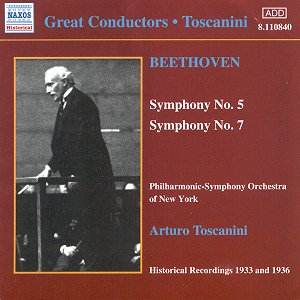 Composer: Ludwig van Beethoven
Composer: Ludwig van Beethoven
Works: Symphony No. 5, Symphony No. 7
Performers: Philharmonic-Symphony Orchestra of New York, Arturo Toscanini (conductor)
Recording: Carnegie Hall, New York, April 1933 (No. 5) and April 1936 (No. 7)
Label: NAXOS HISTORICAL 8.110840
Beethoven’s symphonies stand as monumental pillars of the classical canon, encapsulating the evolution of the symphonic form and the expression of the human experience. The Fifth and Seventh symphonies, composed during pivotal moments in Beethoven’s life, reflect his personal struggles and triumphs, while also resonating with the sociopolitical upheavals of their time. Arturo Toscanini, renowned for his dynamic interpretations, brings a unique perspective to these works in the recordings from the 1930s, capturing the fervor and intricacies of Beethoven’s orchestration with remarkable clarity.
The 1933 recording of the Fifth Symphony is a testament to Toscanini’s interpretative prowess. The famous four-note motif that opens the symphony emerges with a primal intensity, the driving rhythms bursting forth with a precision that is both commanding and unyielding. Toscanini’s approach here is not just to highlight the thematic material but to infuse it with a sense of dramatic urgency. The orchestral balance is notably effective; the strings are lush and full-bodied, while the brass and woodwinds punctuate the texture with a crispness that enhances the overall narrative. However, the 1931 recording, which remains unreleased until Naxos’s forthcoming series, offers a more direct and visceral interpretation that arguably captures the raw power of the symphony more effectively than this 1933 version.
In contrast, the Seventh Symphony, recorded in 1936, showcases Toscanini’s mastery of rhythm and dynamics. The first movement’s Allegretto unfolds with a propulsive energy, each rhythmic pulse resonating with a galvanizing intensity that captivates the listener. The strings are particularly remarkable, achieving a level of articulation that allows Beethoven’s syncopations to breathe and evolve organically. The performance is characterized by its flexibility; Toscanini deftly navigates through the contrasting sections, allowing the music to swell and recede with an almost theatrical flair. Naxos’s inclusion of two takes of the first movement further enriches the listening experience, revealing subtle interpretative differences that underscore Toscanini’s nuanced understanding of the score.
Sound quality in these historical recordings is commendably restored by Mark Obert-Thorn, who has managed to preserve the warmth and depth of the original orchestral textures while minimizing the limitations of the era’s recording technology. The clarity of the orchestral lines allows listeners to appreciate the intricate interplay between sections, an essential aspect of Beethoven’s orchestration. While the recordings inevitably bear the hallmarks of their time, the vibrant sonorities and articulate phrasing serve to enhance the listening experience, making these interpretations invaluable documents of Toscanini’s artistry.
Toscanini’s interpretations of Beethoven’s Fifth and Seventh symphonies, while grounded in historical context, transcend mere reproduction of the scores. They present a vivid narrative that captures the essence of Beethoven’s revolutionary spirit. Compared to other notable renditions, Toscanini’s 1930s recordings stand out for their lyrical richness and rhythmic vitality. The conductor’s ability to shape phrases and manipulate tempo within the confines of the symphonic structure offers listeners a fresh perspective on these well-trodden masterpieces.
The recordings of Beethoven’s Fifth and Seventh symphonies by Toscanini and the Philharmonic-Symphony Orchestra of New York are not only significant historical artifacts but also vibrant performances that continue to resonate with audiences today. They encapsulate the essence of Beethoven’s genius through the lens of one of the 20th century’s most compelling conductors, affirming the enduring power of these works in the orchestral repertoire.



